World Heritage
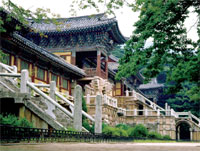
The majestic entrance to Bulguksa Temple
UNESCO has recognized the unique value and the distinct character of Korean culture by placing a number of Korean treasures on the World Heritage List.
In 1995, UNESCO added to its list Bulguksa Temple and Seokguram Grotto, both in Gyeongju, Gyeongsangbuk-do (North Gyeongsang Province); Haeinsa Temple Janggyeongpanjeon, the depositories for the Tripitaka Koreana Woodblocks in Gyeongsangnam-do (South Gyeongsang Province); and Jongmyo, the Royal Ancestral Shrine in Seoul.
Changdeokgung Palace in Seoul and Hwaseong Fortress in Suwon were entered on the list in 1997. In 2000, two additional Korean treasures were added to the list: the dolmen sites of Gochang, Hwasun and Ganghwado (Ganghwa Province); and the Gyeongju Historic Area, the capital of the ancient Silla Kingdom (57 B.C. - A.D. 935), where innumerable cultural treasures and historic sites are carefully preserved. In 2007, UNESCO named Korea's volcanic island Jejudo and its lava tubes a natural property of outstanding beauty which bears testimony to the history of our planet.
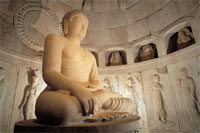
The main rotunda of the Seokguram Grotto
Bulguksa Temple and
Seokguram Grotto were constructed over a 23-year period beginning in 751 during the Silla Kingdom by Chief Minister Kim Dae-seong (701-774). It is recorded that Kim was reincarnated as the son of a chief minister because he had been the virtuous son of a poor widow in a previous life.
He himself became chief minister and resigned in 750 to supervise the construction of Bulguksa to honor the parents of his present life and Seokguram to honor the parents of his previous life. Bulguksa was for public worship and Seokguram for the private worship of the king.
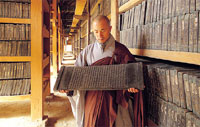
Tripitaka Koreana woodblocks
Built on a series of stone terraces,
Bulguksa blends into what appears as an organic whole with the rocky terrain of the wooded foothills of Tohamsan. The temple houses the Seokgatap (Pagoda of the Historic Buddha) and Dabotap (Pagoda of Many Treasures) as well as Cheongungyo (Blue Cloud Bridge), Baegungyo (White Cloud Bridge) and Chilbogyo (Bridge of Seven Treasures) ― the three staircases are called bridges because symbolically they lead from the secular world to the spiritual one of Buddha.
There are many other outstanding treasures within and outside the temple grounds, including gilt bronze Buddha statues.
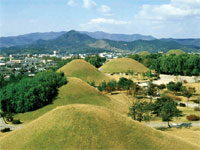
Tombs of Silla Kingdom (57 B.C. - A.D. 935) in Gyeongju, Gyeongsangbuk-do (North Gyeongsang Province)
Dominating the courtyard of the Daeungjeon (Main Hall) are two of Korea's most beautiful pagodas. The 8.3-meter-high Seokgatap and the 10.5-meter-high Dabotap were both built around 756.
Seokgatap is characterized by masculine simplicity and princely dignity and represents spiritual ascent via the teachings of Sakyamuni whereas the highly decorative Dabotap is more feminine and symbolizes the complexity of the world.
Seokguram Grotto has undergone renovation several times over the years. It is an artificially created stone cavern featuring a large seated Buddha surrounded by 38 Bodhisattvas. The grotto, like the structures in the vicinity of Bulguksa, is made from granite.
Seokguram comprises a rectangular antechamber and a round interior chamber with a domed ceiling connected by a passageway. Chiseled out of a single block of granite, the 3.5-meter-high main Buddha is seated cross-legged on a lotus throne facing the east, with eyes closed in quiet meditation, and a serene, all-knowing expression on its face.
Seokguram represents a combination of Silla's knowledge of architecture, math, geometry, physics, religion and art into an organic whole and is one of Korea's greatest Buddhist masterpieces.
Janggyeongpanjeon, two storage halls at Haeinsa Temple, are the repositories for the Tripitaka Koreana, consisting of some 81,258 wood printing blocks, the Goryeo Dynasty (918-1392) version of the Buddhist canon. With more than 52 million Chinese characters precisely rendered, it is the oldest and most comprehensive Buddhist canon existing in the world today.
Jongmyo, the Royal Ancestral Shrine, was dedicated in 1395, three years after the Joseon Dynasty (1392-1910) was established. It enshrines the spirit tablets of its kings and queens. The elaborate memorial rites and the music, which accompanies them called Jongmyojeryeak, were designated as Masterpieces of the Oral and Intangible Heritage of Humanity. Ceremonial reenactments of the Joseon ancestral memorial rites are conducted on the first Sunday of every May at Jongmyo.
Changdeokgung Palace was first built in 1405 and was reconstructed after being burnt down in 1592 during the Japanese invasion. The palace itself is a masterful work but particularly noteworthy is the back garden (Huwon), also called the Secret garden (Biwon), which is widely acclaimed for its beautifully landscaped and creative gardens. The garden comprises almost three-fourths of the 405,636-square-meter palace grounds and is tastefully laid out with all the essential elements of a traditional Korean garden: picturesque pavilions and halls, lotus ponds, uniquely shaped rocks, stone bridges, stairways, water troughs and springs scattered among dense woods.
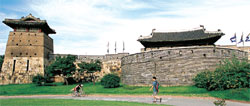
Hwaseong Fortress in Suwon, Gyeonggi-do (Gyeonggi Province)
was constructed over 34 months in Suwon, south of Seoul, in 1796. The fortress incorporated the very latest construction technology, theories of military defense and aesthetic principles to create the most advanced military stronghold Korea had ever known. It stretched over mountainous terrain, around an urban center and through flatland and included four major and several minor gates, command posts, observation towers, battlements, guard posts and bunkers. Most of the 5,743 meter exterior fortress wall still remains.
The
Gyeongju Historic Area and
dolmen sites in the counties of Gochang, Jeollabuk-do; Hwasun, Jeollanam-do; and Ganghwa, Gyeonggi-do (Gyeonggi Province), were also added to the list in 2000. Gyeongju was the capital of the Silla Kingdom for a thousand years and the area is called a “Museum Without Walls” because of the wealth of historical properties there.
Jeju Volcanic Island and Lava Tubes together comprise three sites that make up 18,846 ha. They are Geomunoreum, regarded as the finest lava tube cave system anywhere, with its multicolored carbonate ceilings and floors and dark-colored lava walls; the dramatic fortress-like Seongsan Ilchulbong crater rising out of the ocean; and Hallasan, South Korea's highest mountain, with its waterfalls, multi-shaped rock formations and small crater lake. These sites of outstanding aesthetic beauty also bear testimony to the history of the planet, its features and the processes which formed our world.
Memory of the World
In 1997, UNESCO initiated a Memory of the World Register for the purpose of preserving and disseminating the documentary heritage of the world that is in danger of being lost forever. Korean additions to this registry include Hunminjeongeum (Proper Phonetics to Instruct the People), Joseon Wangjosillok (Annals of the Joseon Dynasty), Buljo Jikjisimcheyojeol (Selected Sermons of Buddhist Sages and Seon Masters), Seungjeongwon Ilgi (Diaries of the Royal Secretariat), the printing woodblocks of the Tripitaka Koreana and miscellaneous Buddhist scriptures, and the Uigwe (Royal Protocols of the Joseon Dynasty).
Hunminjeongeum was a primer for teaching Hangeul, the Korean alphabet created by the Joseon Dynasty's fourth ruler, King Sejong the Great (r. 1418-1450). The new alphabet was promulgated in 1446.
Joseon Wangjosillok resulted from the tradition of preparing a historic record of each reign. It began in 1413 with the Annals of King Taejo, the founder and first king of Joseon, and continued through the end of the dynasty in 1910. The Annals were drafted by historians in the Office for Annals Compilation (Chunchugwan), and to ensure preservation, copies were stored in special repositories situated in different parts of the country.

Starting from left: Joseon Wangjosilok, Buljo Jikjisimcheolyojeol and Seungjeongwon Ilgi
Buljo Jikjisimcheyojeol, compiled in 1372 by the monk Baegun (1298-1374), contains the essentials of Seon (Zen) Buddhism. The key words of the title, “Jikjisimche” were taken from a famous phrase about attaining enlightenment through the practice of Seon. A colophon on the last page of the book states that it was printed with movable metal type at Heungdeoksa Temple in 1377, about seventy years before the Gutenberg Bible was printed in Germany, making it the world's oldest book printed with movable metal type.
The Seungjeongwon, the Royal Secretariat of the Joseon Dynasty, was responsible for keeping the Seungjeongwon Ilgi, a detailed record of the daily events and official schedule of the court, from Joseon Dynasty's first king, Taejo (r. 1392-1398), to the 27th and last, Sunjong (r. 1907-1910). However currently only 3,243 diaries exist. Recorded in the Seungjeongwon Ilgi is the largest amount of authentic historic information and state secrets of the Joseon Dynasty. It served as the primary source for the Annals of the Joseon Dynasty, thus, its historic value is even greater than the Annals itself.
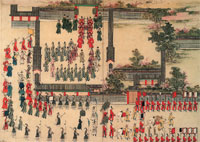
Uigwe: The Royal Protocols of the Joseon Dynasty (1392-1910)
, known as the “Tripitaka Koreana” to modern scholars, is a collection of the Tripitaka (Buddhist scriptures). Carved onto 81,258 wooden printing blocks in the 13th century, under commission by the Goryeo Dynasty (918-1392), it is currently stored at Haeinsa Temple in Gyeongsangnam-do.
A unique form of documentary heritage, the Uigwe is a collection of Royal Protocols for the 500-year-long Joseon Dynasty. A comprehensive and systematic collection of writings and paintings, it provides a detailed account of the important ceremonies and rites of the Joseon court. Its particular style of documentary heritage cannot be found anywhere else in the world.
Intangible Cultural Heritage
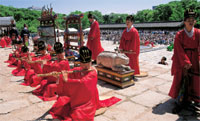
Jongmyojeryeak royal ancestral ritual music
In 1998, UNESCO created the Proclamation of Masterpieces of the Oral and Intangible Heritage of Humanity to protect the oral and intangible cultural heritage of the world. Since the first proclamation in 2001, three intangible cultural treasures of Korea have been proclaimed Masterpieces, and these include the Jongmyo Jerye and Jongmyo-jeryeak (Royal Ancestral Rite and Ritual Music), pansori (epic songs), and the Gangneung Danoje Festival.
Jongmyojerye is the ancestral memorial rite held for the repose of the spirits of the kings and queens of the Joseon period at Jongmyo (the Royal Ancestral Shrine) where their spirit tablets are enshrined.
Jongmyo-jeryeak was performed during the rites. Accompanied by ritual dancing, Botaepyeong (Maintaining the Great Peace) was a suite of 11 pieces praising the civil achievements of the dynastic founders and Jeongdaeeop (Founding a Great Dynasty) was a suite of 15 pieces praising their military accomplishments.
These two works were composed in 1447. Two additional pieces, known as Jongmyoakjang were composed a few years later. Hundreds of officiants, musicians, dancers and attendants take part in the event, which reflects the solemnity and magnificence of Confucian rituals. It is a rare example of an intangible cultural masterpiece that has maintained its original form for 500 years.
Pansori is a genre of musical story-telling, performed by a vocalist with drum accompaniment. These popular solo epic songs, characterized by expressive singing, stylized speech, and mimetic gestures, embrace both aristocratic and folk culture.
Pansori is a compound word from “pan” (a public place where people gather) and “sori” (song). Performances can last up to eight hours, where a male or female singer improvises on texts that combine rural Korean dialects with erudite literary expressions. The settings, characters and situations that make up the pansori are rooted in the Joseon period.
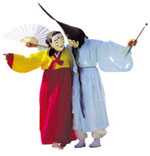
Mask dance from the Gangneung Danoje Festival
, held to pray for a good harvest, falls on the fifth day of the fifth lunar month and marks the end of the spring barley and rice-planting season. Traditionally it was one of the three most important holidays along with Seollal (Lunar New Year's) and Chuseok (Thanksgiving).
Gangneung's Danoje Festival in Gangwon-do (Gangwon Province) is the largest traditional festival in Korea and lasts nearly four weeks in the fourth to early fifth month of the lunar calendar.
The music, dance, literature, drama and handicrafts associated with the festival are of high artistic value and have extraordinary worth in that the festival has continued for approximately a thousand years and reflects the history and life of commoners. The festival also incorporates Korean religious traditions, including Confucianism, Shamanism, Buddhism and Taoism and offers a diversity of ceremonies and performances.